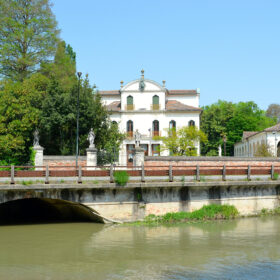
Mira intreccia la sua storia con quella dei canali che ne segnano il territorio in tutte le direzioni.
Nulla di più naturale, perciò, che proporre un itinerario per monumenti seguendo le pigre anse del Brenta, la via acquea principale, che nei secoli vide il progressivo avanzare del dominio veneziano, di cui resta testimonianza nelle ville, negli oratori e nelle chiese, nei casini di caccia, nei palazzi e nelle colonne di confine.
Il viaggio può iniziare in barca (purché dal fondo piatto) da Fusina, per avventurarsi nei meandri silenziosi dei canali che solcano le migliaia di isolotti della Barena, prima che la laguna ceda il passo alla terraferma. È un paesaggio unico, un’oasi naturalistica di grandissimo valore, che la stessa azione dell’uomo (le casse di colmata su cui doveva sorgere la terza zona industriale) non ha apparentemente guastato.
Ripresa la strada, dopo Fusina, ecco subito la Chiusa di Moranzani, uno degli esempi più mirabili delle opere di ingegneria idraulica prodotte dai veneziani. Attraversandola a piedi si raggiunge, poco distante, il luogo in cui le barche caricavano l’acqua potabile per Venezia; acqua che arrivava da Dolo lungo il corso della Seriola, un fossato oggi in parte interrato.
A Malcontenta, l’occhio è catturato dalla imponente bellezza di Villa Foscari che si affaccia su uno dei punti più belli del Naviglio.
Costruita a metà del ‘500 dal Palladio, è ottimamente conservata ed è tra le poche ville visitabili dal pubblico (il martedì e il sabato dalle 9.00 alle 12.00). È una costruzione massiccia ed equilibrata nelle proporzioni; sul lato che guarda al canale, l’austero volume, decorato a bugnato è alleggerito da un grande pronao. All’interno il piano nobile è ornato da un ciclo di affreschi di G.B. Zelotti della seconda metà del ‘500. Nel corso dei secoli vi soggiornarono sovrani e uomini di cultura, mercanti e generali; una delle ultime presenze illustri fu la Regina Elisabetta d’Inghilterra durante la sua visita in Italia nel 1966.
Proseguendo lungo la statale che costeggia il Naviglio Brenta si incontra, all’ingresso di Oriago, il “Termine”, pilastro del 1375 che segnava gli antichi confini di Venezia. Quindi, sempre sulla riva sinistra, ecco la settecentesca Villa Allegri in cui soggiornò anche il Generale Radetsky, e subito dopo l’antico Palazzo Moro, del ‘400, la cui facciata conserva “murata” la lapide con i versi danteschi del V Canto del Purgatorio in cui si narra la morte, qui avvenuta, di Jacopo del Cassero. Siamo così giunti ad Oriago, la cui parrocchiale dedicata a Santa Maria Maddalena presenta un campanile romanico a cella ottagonale decorato da formelle di terracotta.
La chiesa, iniziata nel ‘400 e modificata nel secolo successivo, è a navata unica con cappelle laterali. Tra le tele conservate all’interno è interessante quella posta sulla nave di destra, “noli me tangere” attribuita a Francesco Vecellio (1475-1559). Il soffitto è opera moderna (1947), realizzata da Beppi Spolaor (1910-1950). Sulla riva destra spiccano Palazzo Mocenigo, completamente restaurato ad opera del Comune (e ora sede del Dipartimento di Economia del Turismo dell’Università di Venezia) e la cinquecentesca Villa Gradenigo. L’edificio, in ottime condizioni, presenta all’interno notevoli cicli pittorici, in parte attribuiti a Benedetto Caliari (1538-1598), fratello di Paolo Veronese.
Da Oriago, attraversata Piazza Mercato (il cui nome testimonia la presenza del mercato settimanale fin dal 1500), abbandonando il canale e percorrendo Via Risorgimento, si giunge attraverso un tranquillo paesaggio di campagna, a Gambarare, la cui Chiesa Parrocchiale, dedicata a San Giovanni Battista, è una delle più belle della Riviera, con il suo piccolo campanile romanico. Ha una storia antichissima, avendo raccolto l’eredità del Monastero di Sant’Ilario quando questo, alla fine del 1200, andò in rovina.
Al suo interno, ottimamente restaurato, un organo costruito dal Callido (1727-1813), il maggior organaro veneto del ‘700, e una lapide con trascritta la bolla papale con cui nel 1508 Giulio II riconosceva all’assemblea dei capifamiglia cattolici il privilegio di scegliere il parroco tra una rosa di nomi proposti dal Patriarca di Venezia, privilegio cessato nel 1998 con la nomina dell’ultimo parroco. Costituita da una sola navata, l’arcipretale termina con un’abside affiancata da due altari. Interessante, a sinistra, la cinquecentesca fonte battesimale e il pulpito sovrastato da affreschi recenti di C.B. Tiozzo. Nella sacrestia sono custoditi due importanti armadi seicenteschi in noce, una deposizione di Gesù, della bottega di Palma il Giovane, e due statue lignee cinquecentesche raffiguranti i Santi Giovanni e Paolo.
Tornati lungo il Brenta, dopo Oriago, ci si imbatte in uno degli angoli più suggestivi della Riviera: Valmarana. Della villa omonima rimangono solo le due grandi barchesse laterali, poiché il corpo centrale fu abbattuto dai proprietari, alla fine del secolo scorso, per questioni fiscali. Quasi di fronte, attorniata da uno splendido giardino, sorge la settecentesca Villa Widmann-Foscari, elegante, ricca di decorazioni e dipinti. Ospitò, tra gli altri, Goldoni, D’Annunzio e Strawinsky. All’interno il salone delle feste è decorato con un ciclo di affreschi a soggetto mitologico. Di proprietà dell’Amministrazione Provinciale di Venezia, la villa è stata di recente splendidamente restaurata ed è quindi nuovamente aperta al pubblico, che può così ammirarne anche il grande parco. Poco oltre, sull’altra riva, immersa nel verde c’è Villa Valier con la Barchessa e la chiesetta seicentesca. Un dipinto di Alessandro Maganza, raffigurante una suonatrice di chitarra (ora esposto all’Accademia di Venezia) diede il nome di “Chitarra” a tutta la località.
Solo pochi metri, e sul Brenta si affaccia la cinquecentesca Villa Querini-Stampalia. Al suo interno, un prezioso ciclo di affreschi, opera di B. De Pitati e della sua bottega, per la quale lavorarono anche i giovani Tintoretto e Bassano. Si entra così a Mira Porte, piccolo borgo praticamente intatto con le sue case a schiera seicentesche, alcune delle quali conservano ancora l’orto retrostante. La statale, con il suo traffico, è poco lontana, eppure qui il tempo sembra essersi fermato. In passato fino a settant’anni fa al posto della piazza sorgevano le chiuse, che si attraversavano con un ponte mobile. La località era metà di viaggiatori e mercanti, che spesso sostavano nei due alberghi del posto
Il nostro itinerario ci permette di vedere quindi le Ville Franceschi e Principe Pio, l’ultracentenario Mulino Simionato, ancora in attività e la parrocchiale di San Nicolò, con la bella canonica secentesca. L’intitolazione a San Nicolò della chiesa testimonia il ruolo fondamentale dei barcaioli nell’economia del paese nei secoli passati. San Nicolò era infatti il loro patrono e Mira, in Turchia, era la sua città di origine, e divenne anche il nome del paese sostituendo quello più antico di Cazoxana. Nei secoli, pur mantenendo l’originale struttura perimetrale, la chiesa ha subito numerosi rimaneggiamenti. Anche il campanile attuale non è quello originale ma una costruzione novecentesca. L’interno è a tre navate con decorazioni tardo-settecentesche del presbiterio; mentre sulla navata sinistra merita attenzione una pala raffigurante “Sant’Antonio da Padova e Gesù Bambino”.
Proseguendo lungo il viale alberato che costeggia il Naviglio Brenta in questo punto, si raggiunge Villa Contarini detta “dei Leoni”, per le due belle sculture poste all’ingresso. Non sono gli originali, dal momento che questi, assieme ai preziosi affreschi del Tiepolo eseguiti nel 1754, che ornavano il salone a pianterreno e raffiguranti la sosta a Mira di Enrico di Valois di ritorno in Francia dalla Polonia, furono venduti dai proprietari nel 1893 e si trovano attualmente a Parigi, al Museo Jacquemart-André. Il parco retrostante, a giardino italiano, ospita diverse varietà vegetali. Anche a Mira Taglio numerose ville costeggiano il canale intervallate da case a schiera d’epoca: procedendo verso Padova, si incontrano, a destra, Villa Corner e Villa Bon, a sinistra Villa Levi-Morenos e Foscarini dei Carmini. Una lapide, sulla facciata di quest’ultima, ricorda che qui soggiornò a lungo, tra il 1817 e il 1819, il poeta inglese George Byron. Altre splendide testimonianze della presenza veneziana accompagnano la parte finale dell’itinerario lungo il Naviglio: le Ville Alessandri, Swift-Barozzi, Querini Moro-Lin, Bonlini Pisani, Palazzo Boldù, Villa Venier e Villa Selvatico Granata.
L’itinerario turistico-storico lungo il Naviglio Brenta è possibile, da Marzo a Ottobre, anche per via acquea a bordo del Burchiello.

Mira intertwines its history with that of the canals that mark its territory in all directions.
Nothing is more natural, therefore, than to propose an itinerary through monuments following the lazy bends of the Brenta, the main waterway, which over the centuries saw the progressive advance of Venetian rule, of which remains testimony in the villas, oratories and churches, in the hunting lodges, in palaces and border columns.
The journey can start by boat (provided it has a flat bottom) from Fusina, to venture into the silent meanders of the canals that plow through the thousands of islets of the Barena, before the lagoon gives way to the mainland. It is a unique landscape, a naturalistic oasis of great value, which the very action of man (the bridging boxes on which the third industrial area was to rise) has apparently not spoiled.
Back on the road, after Fusina, here is the Chiusa di Moranzani, one of the most admirable examples of the hydraulic engineering works produced by the Venetians. Crossing it on foot you reach, not far away, the place where the boats loaded the drinking water for Venice; water that came from Dolo along the course of the Seriola, a moat that is now partially buried.
In Malcontenta, the eye is captured by the imposing beauty of Villa Foscari which overlooks one of the most beautiful points of the Naviglio.
Built in the mid-16th century by Palladio, it is well preserved and is one of the few villas that can be visited by the public (www.lamalcontenta.com). It is a massive construction with balanced proportions; on the side facing the canal, the austere volume, decorated with ashlar, is lightened by a large pronaos. Inside, the main floor is decorated with a cycle of frescoes by G.B. Zelotti from the second half of the 16th century. Over the centuries sovereigns and men of culture, merchants and generals stayed there; one of the last illustrious presences was Queen Elizabeth of England during her visit to Italy in 1966.
Continuing along the state road that runs along the Naviglio Brenta, at the entrance to Oriago, you will find the “Termine”, a pillar dating back to 1375 that marked the ancient borders of Venice. Then, again on the left bank, there is the eighteenth-century Villa Allegri where General Radetsky also stayed, and immediately after the ancient Palazzo Moro, from the 15th century, whose facade preserves the plaque with the Dante verses of the V Canto del Purgatory in which the death, which took place here, of Jacopo del Cassero is told. We have thus come to Oriago, whose parish church dedicated to Santa Maria Maddalena has a Romanesque bell tower with an octagonal cell decorated with terracotta tiles.
The church, begun in the 1400s and modified in the following century, has a single nave with side chapels. Among the paintings preserved inside, the one placed on the right ship, “noli me tangere” attributed to Francesco Vecellio (1475-1559) is interesting. The ceiling is a modern work (1947), made by Beppi Spolaor (1910-1950). On the right bank stand out Palazzo Mocenigo, completely restored by the Municipality (and now home to the Department of Economics of Tourism of the University of Venice) and the sixteenth-century Villa Gradenigo. The building, in excellent condition, has considerable pictorial cycles inside, partly attributed to Benedetto Caliari (1538-1598), brother of Paolo Veronese.
From Oriago, crossing Piazza Mercato (whose name testifies to the presence of the weekly market since 1500), leaving the canal and walking along Via Risorgimento, you reach Gambarare through a peaceful countryside landscape, whose Parish Church, dedicated to San Giovanni Battista, is one of the most beautiful on the Riviera, with its small Romanesque bell tower. It has a very ancient history, having collected the legacy of the Monastery of Sant’Ilario when it fell into disrepair at the end of 1200.
Inside, well restored, an organ built by Callido (1727-1813), the greatest Venetian organ builder of the 18th century, and a plaque with the papal bull transcribed with which in 1508 Julius II recognized the privilege of choose the parish priest among a list of names proposed by the Patriarch of Venice, a privilege that ended in 1998 with the appointment of the last parish priest. Consisting of a single nave, the archpriest ends with an apse flanked by two altars. Interesting, on the left, the sixteenth-century baptismal font and the pulpit surmounted by recent frescoes by C.B. Tiozzo. In the sacristy there are two important seventeenth-century wardrobes in walnut, a deposition of Jesus, from the workshop of Palma the Younger, and two sixteenth-century wooden statues depicting Saints John and Paul.
Back along the Brenta, after Oriago, you come across one of the most evocative corners of the Riviera: Valmarana. Of the villa of the same name, only the two large side barns remain, as the central body was demolished by the owners at the end of the last century for tax reasons.
Almost opposite, surrounded by a splendid garden, stands the eighteenth-century Villa Widmann-Foscari, elegant, rich in decorations and paintings. It hosted, among others, Goldoni, D’Annunzio and Strawinsky. Inside, the party hall is decorated with a cycle of mythological frescoes. Owned by the Provincial Administration of Venice, the villa has recently been beautifully restored and is therefore open again to the public, who can thus also admire the large park. A little further on, on the other bank, surrounded by greenery, is Villa Valier with the Barchessa and the seventeenth-century church. A painting by Alessandro Maganza, depicting a guitar player (now exhibited at the Venice Academy) gave the name of “Guitar” to the whole town.
Only a few meters away, the sixteenth-century Villa Querini-Stampalia overlooks the Brenta. Inside, a precious cycle of frescoes, the work of B. De Pitati and his workshop, for which the young Tintoretto and Bassano also worked. This leads to Mira Porte, a small village practically intact with its seventeenth-century terraced houses, some of which still retain the back garden. The state road, with its traffic, is not far away, yet here time seems to have stopped. In the past until seventy years ago, locks stood in place of the square, which were crossed with a mobile bridge. The locality was half of travelers and merchants, who often stopped in the two local hotels
Our itinerary therefore allows us to see the Ville Franceschi and Principe Pio, the more than one hundred year old Mulino Simionato, still in business and the parish church of San Nicolò, with the beautiful seventeenth-century rectory. The naming of the church after San Nicolò testifies to the fundamental role of boatmen in the town’s economy in past centuries. San Nicolò was in fact their patron and Mira, in Turkey, was his city of origin, and also became the name of the town, replacing the older one of Cazoxana. Over the centuries, while maintaining the original perimeter structure, the church has undergone numerous alterations. Even the current bell tower is not the original one but a twentieth-century construction. The interior has three naves with late-eighteenth-century decorations of the presbytery; while on the left aisle an altarpiece depicting “Saint Anthony of Padua and the Child Jesus” deserves attention.
Continuing along the tree-lined avenue that runs along the Naviglio Brenta at this point, you reach Villa Contarini called “dei Leoni”, due to the two beautiful sculptures placed at the entrance. They are not the originals, since these, together with the precious frescoes by Tiepolo painted in 1754, which adorned the ground floor hall and depicting Henry of Valois’s stop in Mira on his return to France from Poland, were sold by the owners in 1893 and they are currently in Paris, at the Jacquemart-André Museum. The park behind it, like an Italian garden, hosts various plant varieties. In Mira Taglio, too, numerous villas line the canal interspersed with period terraced houses: proceeding towards Padua, on the right, you will find Villa Corner and Villa Bon, on the left Villa Levi-Morenos and Foscarini dei Carmini. A plaque on the facade of the latter recalls that the English poet George Byron stayed here for a long time, between 1817 and 1819. Other splendid testimonies of the Venetian presence accompany the final part of the itinerary along the Naviglio: the Ville Alessandri, Swift-Barozzi, Querini Moro-Lin, Bonlini Pisani, Palazzo Boldù, Villa Venier and Villa Selvatico Granata.
The tourist-historical itinerary along the Naviglio Brenta is possible, from March to October, also by water on board the Burchiello.







